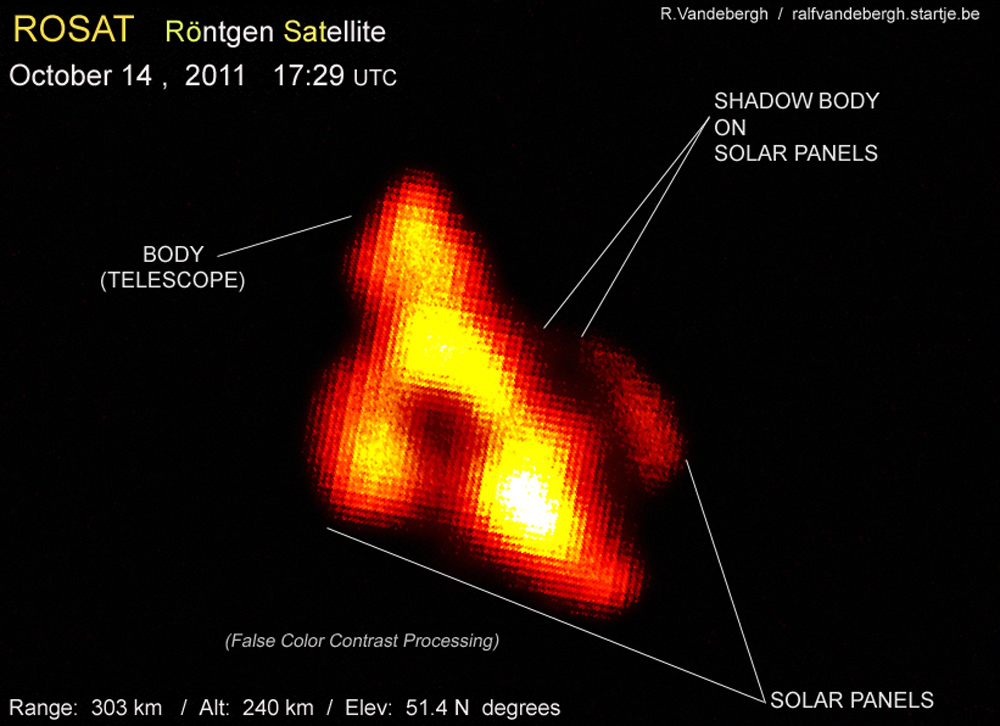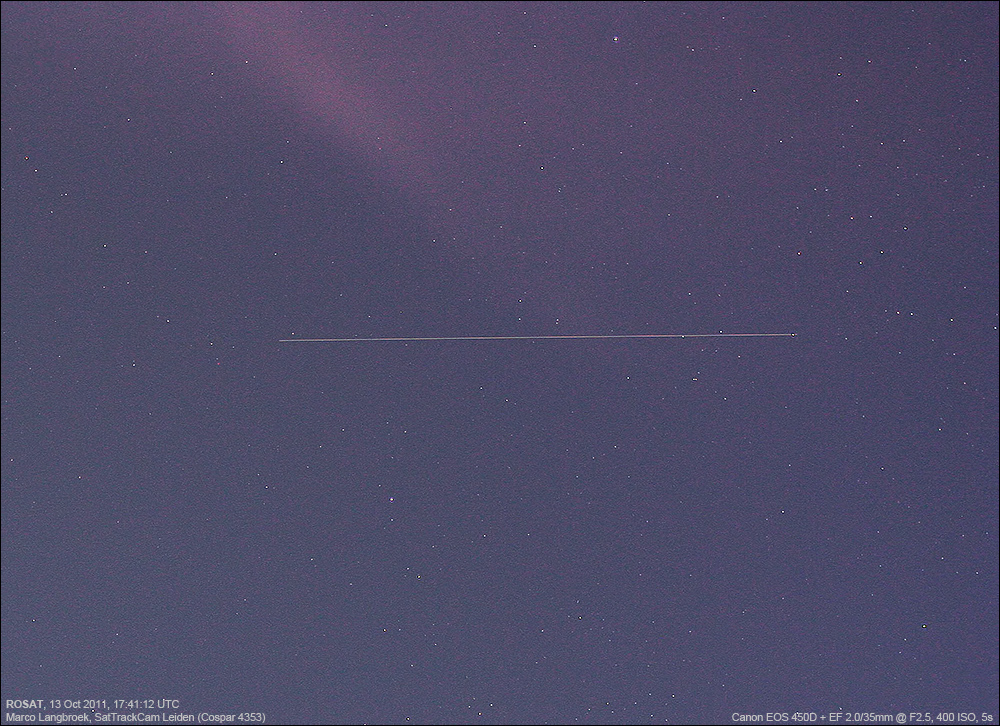Skywatcher Photos Show Last Days of Falling German Satellite

Skywatchers in Europe have snapped some of the final photos of a doomed German satellite slated to plunge to Earth this weekend in an uncontrolled death dive.
The photos show the defunct 21-year-old Roentgen Satellite, or ROSAT, as the spacecraft spent its final days in orbit. The 2.7-ton ROSAT is expected to fall to Earth sometime between Saturday afternoon or Sunday morning (Oct. 22 or 23), but scientists cannot predict exactly when or where the satellite will be when it begins its fiery plunge through Earth's atmosphere.
During ROSAT's last days in space, skywatchers around the world have trained their eyes — as well as cameras and telescopes — on the satellite.
Veteran satellite spotter Ralf Vandebergh in the Netherlands has been keeping a close tabs on ROSAT using a camera-equipped telescope, and even snapped a photo for SPACE.com this week that showed the satellite's body and solar panels.
"Since ROSAT fell to a lower height in recent times, it [has] became increasingly difficult to spot him," Vandebergh told SPACE.com in an email. "Luckily we had, in the past week, several passes in the early dusk so the satellite was still well-lit." [Photos of the falling ROSAT satellite]
ROSAT, Vandebergh said, has been a bit harder to observe than NASA's school bus-size Upper Atmosphere Research Satellite (UARS), which also fell to Earth last month. NASA's UARS satellite was a huge object weighing nearly 6.5 tons. ROSAT is smaller, weighing about 2.7 tons.
"ROSAT is a rather difficult object in the telescope, due its relatively small size," Vandebergh said. "Details are therefore much harder to photograph than, for example UARS."
Get the Space.com Newsletter
Breaking space news, the latest updates on rocket launches, skywatching events and more!

Another skywatcher who spotted ROSAT is Marco Langbroek, who snapped a striking long-exposure photo of the spacecraft as it passed over Leiden in the Netherlands.
"It is moving very fast, quite a spectacular view," Langbroek told SPACE.com. "It takes less than a minute for it to travel over a significant part of the sky."
The key to spotting ROSAT has been knowing where to look, he added.
"You have to keep a close watch on the relevant parts of the sky though, as it is gone again before you know it," Langbroek said.
German Aerospace Center officials have said they cannot predict exactly where and when ROSAT will fall to Earth, but they do expect at least 30 large pieces of the satellite to survive the fiery re-entry through the atmosphere and hit the planet. Altogether, about 1.7 tons of the satellite debris could rain down over a 50-mile (80-kilometer) stretch of the Earth's surface, German space officials have said.
There is a 1-in-2,000 chance that ROSAT debris could injure one of the nearly 7 billion people on Earth, but the actual personal risk per person is extremely remote, they added.
"Where any remnants of ROSAT will fall is currently difficult to say, it is most likely that it falls just as UARS in the ocean, because it covers the most area," Vandebergh said. "Though we should watch out, as we could be misled now by the fact that UARS fell in the ocean. Maybe this time it's different."
Editor's note: If you snap a photo or observe the re-entry of the ROSAT satellite and want to share it with SPACE.com for a story or gallery, contact managing editor Tariq Malik at: tmalik@space.com.
You can follow SPACE.com Managing Editor Tariq Malik on Twitter @tariqjmalik. Follow SPACE.com for the latest in space science and exploration news on Twitter @Spacedotcom and on Facebook.
Join our Space Forums to keep talking space on the latest missions, night sky and more! And if you have a news tip, correction or comment, let us know at: community@space.com.

Tariq is the Editor-in-Chief of Space.com and joined the team in 2001, first as an intern and staff writer, and later as an editor. He covers human spaceflight, exploration and space science, as well as skywatching and entertainment. He became Space.com's Managing Editor in 2009 and Editor-in-Chief in 2019. Before joining Space.com, Tariq was a staff reporter for The Los Angeles Times covering education and city beats in La Habra, Fullerton and Huntington Beach. In October 2022, Tariq received the Harry Kolcum Award for excellence in space reporting from the National Space Club Florida Committee. He is also an Eagle Scout (yes, he has the Space Exploration merit badge) and went to Space Camp four times as a kid and a fifth time as an adult. He has journalism degrees from the University of Southern California and New York University. You can find Tariq at Space.com and as the co-host to the This Week In Space podcast with space historian Rod Pyle on the TWiT network. To see his latest project, you can follow Tariq on Twitter @tariqjmalik.









